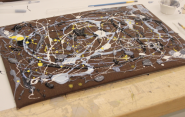The Physics of Jackson Pollock and Helen Frankenthaler at the CEID

A Jackson Pollock painting may look chaotic, but there’s science to all that abstract expressionism. At the Yale Center for Engineering Innovation and Design (CEID), paintings conservator Cindy Schwarz and research scientist Kate Schilling led a workshop on the physics of Pollock and Helen Frankenthaler paintings.
Attendees also tried their own hand at these techniques. Students learned not only about the artists and the relevant history, but about how the rheology of paint and processes like surface tension, capillary action, and diffusion work together to create the visual styles of Pollock and Frankenthaler.
Schilling noted that it was 1940s paint technology that allowed Pollock and Frankenthaler to work as they did. Rather than brushing the paint onto the canvas in the conventional method, Pollock tended to let it drop onto a canvas placed on the floor. But to do this with a certain amount of control required a paint with specific properties.
“The development of cellulose nitrate/enamel, alkyd, and acrylic paints created a different range of viscosities, densities, and also drying speeds,” Schilling said. “Oil paints take about a year to dry fully, so it wouldn’t have worked for what they were trying to do.”
Schilling adds, though, that Frankenthaler used oil paints because she liked how they soaked into the canvas. When she changed to acrylic paints, she wrote about having to “push the paint” into the canvas with her hands because the surface tension and viscosity kept it from being taken up so readily by the canvas fibers.
“Artists’ materials are their language, so as new materials are designed, artists can express their ideas in new and different ways,” Schilling said. “Once paint started flying in the CEID, the students saw firsthand how controlling the fluid properties of the paint and the canvas impacts the artistic outcome.”


